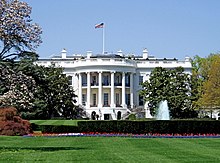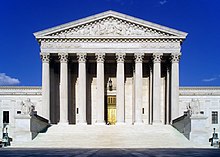Main articles: Federal government of the United States, state governments of the United States, and elections in the United States
The United States is the world's oldest surviving federation. It is a constitutional republic and representative democracy, "in which majority rule is tempered by minority rights protected by law".[55] The government is regulated by a system of checks and balances defined by the U.S. Constitution, which serves as the country's supreme legal document.[56] In the American federalist system, citizens are usually subject to three levels of government, federal, state, and local; the local government's duties are commonly split between county and municipal governments. In almost all cases, executive and legislative officials are elected by a plurality vote of citizens by district. There is no proportional representation at the federal level, and it is very rare at lower levels.- Legislative: The bicameral Congress, made up of the Senate and the House of Representatives, makes federal law, declares war, approves treaties, has the power of the purse, and has the power of impeachment, by which it can remove sitting members of the government.
- Executive: The president is the commander-in-chief of the military, can veto legislative bills before they become law, and appoints the members of the Cabinet (subject to Senate approval) and other officers, who administer and enforce federal laws and policies.
- Judicial: The Supreme Court and lower federal courts, whose judges are appointed by the president with Senate approval, interpret laws and overturn those they find unconstitutional.
The state governments are structured in roughly similar fashion; Nebraska uniquely has a unicameral legislature. The governor (chief executive) of each state is directly elected. Some state judges and cabinet officers are appointed by the governors of the respective states, while others are elected by popular vote.
The original text of the Constitution establishes the structure and responsibilities of the federal government and its relationship with the individual states. Article One protects the right to the "great writ" of habeas corpus, and Article Three guarantees the right to a jury trial in all criminal cases. Amendments to the Constitution require the approval of three-fourths of the states. The Constitution has been amended twenty-seven times; the first ten amendments, which make up the Bill of Rights, and the Fourteenth Amendment form the central basis of Americans' individual rights. All laws and governmental procedures are subject to judicial review and any law ruled in violation of the Constitution is voided. The principle of judicial review, not explicitly mentioned in the Constitution, was declared by the Supreme Court in Marbury v. Madison (1803).
Parties and ideology
Main articles: Politics of the United States and Political ideologies in the United States

Barack Obama taking the presidential oath of office from U.S. Chief Justice John Roberts, January 20, 2009
Within American political culture, the Republican Party is considered center-right or conservative and the Democratic Party is considered center-left or liberal. The states of the Northeast and West Coast and some of the Great Lakes states, known as "blue states", are relatively liberal. The "red states" of the South and parts of the Great Plains and Rocky Mountains are relatively conservative.
The winner of the 2008 presidential election, Democrat Barack Obama, is the 44th U.S. president. The 2010 midterm elections saw the Republican Party take control of the House and make gains in the Senate, where the Democrats retain the majority. In the 112th United States Congress, the Senate comprises 51 Democrats, two independents who caucus with the Democrats, and 47 Republicans; the House comprises 242 Republicans and 192 Democrats—one seat is vacant. There are 29 Republican and 20 Democratic state governors, as well as one independent.
Tuesday, June 12, 2012




No comments:
Post a Comment